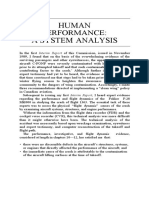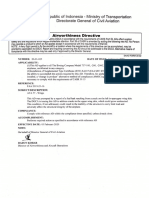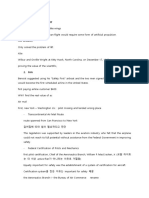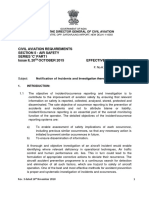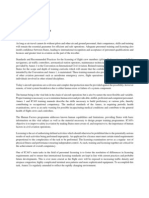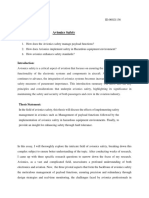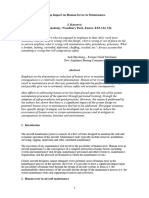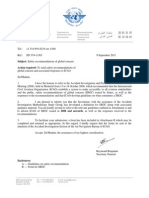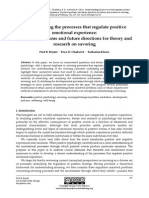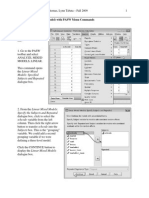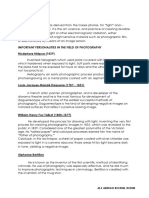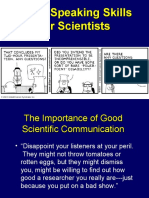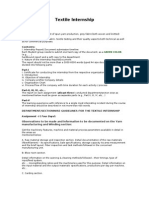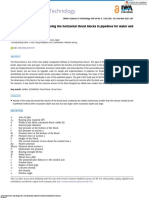Georgiou S08
Georgiou S08
Uploaded by
fordleeCopyright:
Available Formats
Georgiou S08
Georgiou S08
Uploaded by
fordleeCopyright
Available Formats
Share this document
Did you find this document useful?
Is this content inappropriate?
Copyright:
Available Formats
Georgiou S08
Georgiou S08
Uploaded by
fordleeCopyright:
Available Formats
Effect of Human Factors in Aviation Maintenance 1
The Effect of Human Factors in Aviation Maintenance Safety
Andrea M. Georgiou
Middle Tennessee State University
Effect of Human Factors in Aviation Maintenance 2
Abstract
With the recent media attention on major airlines such as Southwest and American Airlines,
public concerns have greatly increased for aviation maintenance safety. There are several factors
that play into the cause of aircraft accidents and some of these factors are known as human
factors. The study of how humans can most efficiently interact with technology is known as
human factors. According to Boeing, the worlds largest aircraft manufacturer, human error
accounts for 70% of commercial airplane accidents. In order to decrease the number of accidents
caused by maintenance-related human factors, awareness and training in the field of human
factors is critical. This research aims to qualitatively investigate the type of human factor that
exist in aviation maintenance as well as the extent to which the factors affect safety performance.
Furthermore, the researcher wanted to find the number of accidents that were caused by
maintenance-related errors in the ten year span of 1996 through 2006. The results indicate the top
three mechanical errors with the highest number of fatalities in order were: a).failure to properly
complete tasks, b).improper maintenance, and c).improper installations. In addition, the human
factors that were most prevalent among the attitudes of both Aviation Maintenance Technicians
(AMTs) and the Federal Aviation Administration (FAA) officials were demanding deadlines,
environmental and personal distractions, and lack of proper use of maintenance manuals or
instructions.
Effect of Human Factors in Aviation Maintenance 3
Chapter 1
Introduction
In view of affordable air travel prices, a vast majority of the population from the working
class to the upper class travel through the air transportation industry and are therefore directly
affected by aviation safety. The large scope of individuals concerned with safe air travel forces
the constant surveillance of accidents and incidents by the Federal Aviation Administration
(FAA) government agency, National Transportation Safety Board (NTSB), researchers, and
public attention through media. Most recently, Southwest Airlines gained some unwanted
attention when the largest fine in FAA history was issued of 10.2 million dollars for allegedly
flying at least 117 of its planes in violation of mandatory safety checks (Levine, 2008; Griffin &
Bronstein, 2008). Not only does this place increased attention towards Southwest Airlines, but
also places scrutiny ten -fold in maintenance departments within all commercial airlines.
Even with the rapidly increasing advances in technology, humans hold the ultimate
responsibility in ensuring the success and safety in the aviation industry. Due to the fact humans
are an integral and necessary part of air safety, the study of how humans can most efficiently
interact with technology is known as human factors. According to Boeing, the worlds largest
aircraft manufacturer, human error accounts for 70% of commercial airplane accidents. Placing
extreme importance on the role of human factors in aviation, Boeing studies various human
factors and translates it into design, training, policies, or procedures to help humans perform
better (Graeber, n.d.) Although maintenance-related accidents are far less frequent than
accidents caused by pilot error, the end result can be just as fatal. Maintenance personnel, pilots,
Air Traffic Control (ATC), and Flight Dispatchers are just a portion of the people dedicated to
Effect of Human Factors in Aviation Maintenance 4
ensure a flight travels safely from departure to arrival. While there are several facets impacting
the safety of a flight, it begins on the ground with the Aviation Maintenance Technician (AMT),
also known as Airframe and Powerplant (A & P) mechanic.
Overarching research questions
1. How many aircraft accidents with at least one fatality have occurred due to maintenance
error from 1996 through 2006?
2. What human factors and to what extent do human factors affect a mechanics, AMT,
ability to safely conduct maintenance?
3. What are some cost-efficient solutions to decrease the effects of human factors which
would result in an increase in aviation safety?
Acronyms
AD- Airworthiness Directive
AMT- Aviation Maintenance Technician
A&P- Airframe and Powerplant mechanic
FAA- Federal Aviation Administration
FAR- Federal Aviation Regulations
IA- Inspection Authorization
NTSB- National Transportation Safety Board
Effect of Human Factors in Aviation Maintenance 5
Definitions
1. Airframe and Powerplant (A&P) mechanic- a licensed mechanic who has taken Airframe,
General and Powerplant computerized FAA exams, as well as an Oral and Practical exam
given by an FAA official or a person designated by the FAA known as Designated
Maintenance Examiner (DME). A & P mechanic is privileged to perform
2. Airworthiness Directive (AD) - FAA issues ADs informing owner/operator/mechanic
that an unsafe condition exists and action must be taken to ensure safety. AD compliance
is mandatory and each AD will specify applicability by make and model of aircraft and
will also give mandatory compliance procedures. If an AD is not complied with by the
specified time noted in an AD that aircraft is considered unairworthy and therefore illegal
to fly until appropriately rated mechanic complies with AD instructions.
3. Aviation Maintenance Technician(AMT) - same as above definition for Airframe and
Powerplant mechanic.
4. Code of Federal Regulations (CFR) - codification of general and permanent rules and
permanent rules published in the Federal Register. The Code is divided into 50 titles, and
Title 14 covers topics pertaining to Aeronautics and Space. Regulatory entities are the
Federal Aviation Administration (FAA) and Department of Transportation (DOT).
5. Corrosion- a natural occurrence that attacks metal by chemical or electrochemical action
and converts it back to a metallic compound. Corrosion that goes untreated and
undetected can lead to fatal consequences. (AC 43.131B, chapter 6)
Effect of Human Factors in Aviation Maintenance 6
6. Engine overhaul- According to FAR 43.2, an engine is overhauled when using methods,
techniques, and practices acceptable to the Administrator, it has been disassembled,
cleaned, inspected, repaired as necessary, and reassembled; and it has been tested to
approved standards and technical data.
7. Experimental aircraft-also known as Experimental Amateur-Built or Homebuilt aircraft-
builder has built as last 51% of the airplane for recreational or educational purposes.
Requires a pilot certificate, but does not require a mechanic certificate. Experimental
aircraft are subject to condition inspections every 12 calendar months.
8. Fatigue cracking-Fatigue cracks can form in any load-carrying structure during normal
use. Corrosion damage leads to cracks in the metal resulting in fatigue cracks which can
sometimes lead to catastrophic results. In April 1988, a Boeing 737 in Hawaii brought
national attention to the problems of fatigue cracks in aircraft. In this accident, the upper
portion of the aircraft was ripped apart in flight due to a fatigue crack in the structure.
9. Federal Aviation Administration (FAA) - the federal agency responsible for the safety of
civil aviation. With the Federal Aviation Act of 1958, the agency was originally named
Federal Aviation Agency; however, when they became part of the Department of
Transportation in 1967 they adopted the name Federal Aviation Administration.
10. Inspections-
Annual inspection- aircraft is completely inspected with a checklist every 12
calendar months by a person authorized in FAR 43.7, such as a mechanic holding
an Inspection Authorization (IA) . An A&P may not perform annual inspections.
The annual checklist is derived from various sources depending on the program
Effect of Human Factors in Aviation Maintenance 7
the FAA approved for a particular aircraft. A checklist frequently used comes
from the 14 CFR part 43 Appendix D, Scope and Detail for 100 hour and annual
inspection.
100 hr inspection- differs from annual inspection with regard to the time in which
inspection is completed. Every 100 hours time in service an aircraft must undergo
a 100 hour inspection. An A&P may perform 100 hour inspection, along with
Inspection Authorization (IA), and others authorized by 14 CFR part 43.7
Condition inspection- According to 14 CFR part 65.104, an experimental aircraft
must have a condition inspection on the aircraft constructed by the holder in
accordance with the operating limitations of that aircraft. An experimental aircraft
will not have annual/100 hour inspections, rather the inspection is called a
condition inspection.
Progressive inspection- the scope and detail for a progressive inspection is
developed by the owner/operator in accordance with 14 CFR part 91.409 and
approved by the FAA.
11. Inspection Authorization (IA)-According to 14 CFR part 65, in order to obtain the
Inspection Authorization rating a mechanic must hold an A&P for at least 3 years and be
actively engaged in maintaining aircraft for the previous 2 years before the application.
An IA is privileged to return to service any aircraft, airframe, engine, appliance or part
after a major repair or major alteration except aircraft in part 121 maintained in a
continuous airworthiness program. An IA can perform annual inspections, an A&P
cannot perform annual inspections.
Effect of Human Factors in Aviation Maintenance 8
12. Kit- experimental aircraft / homebuilt aircraft where some of the airplane is already
fabricated and builder purchases the kit.
13. National Transportation Safety Board (NTSB) - an independent Federal agency dedicated
to promoting aviation, railroad, highway, marine, pipeline, and hazardous materials
safety. Established in 1967, the agency is mandated by Congress through the Independent
Safety Board Act of 1974 to investigate transportation accidents, determine the probable
causes of the accidents, issue safety recommendations, study transportation safety issues,
and evaluate the safety effectiveness of government agencies involved in transportation.
The Safety Board makes public its actions and decisions through accident reports, safety
studies, special investigation reports, safety recommendations, and statistical reviews.
14. Accident- includes events in which any person suffers fatal or serious injury, or in which
the aircraft receives substantial damage or is destroyed. An event that results in minor or
no damage is not classified as an accident.
15. NTSB Definitions for level of injury- (http://www.ntsb.gov/publictn/2004/ARG0401.pdf)
Fatal - Any injury that results in death within 30 days of the accident.
Serious- Any injury which:
(1) requires hospitalization for more than 48 hours, commencing within 7 days from
the date the injury was received;
(2) results in a fracture of any bone (except simple fractures of fingers, toes, or nose);
(3) causes severe hemorrhages, nerve, muscle, or tendon damage;
(4) involves any internal organ; or
(5) involves second- or third-degree burns, or any burns affecting more than 5% of
the body surface.
Effect of Human Factors in Aviation Maintenance 9
Minor- Any injury that is neither fatal nor serious.
16. Overhaul shop- mechanic shop that performs overhauls on aircraft, aircraft engine,
airframe, component or other parts.
17. Owner/builder, owner/pilot- mechanics, pilot/builder, owner/operator- describes the
roles in which the person played in regard to the aircraft. None of these terms means the
person holds a valid mechanics license such as an A&P or IA.
18. 14 CFR Part 91- Regulations that pertain to operating rules in general aviation
19. 14 CFR Part 121- Regulations that pertain to operating rules in domestic, flag, and
supplemental operations. Major airlines such as Southwest Airlines and American
airlines operate under part 121.
20. 14 CFR Part 133- Regulations that pertain to rotorcraft (helicopter) external -load
operations.
21. 14 CFR Part 135- Regulations that pertain to air taxi and commuter nonscheduled
operations.
22. 14 CFR Part 137- Regulations that pertain to agricultural aircraft operations.
23. Service bulletin-manufacturer issues a notice informing owner/operator an unsafe
condition exists that should be addressed in order to safely fly the aircraft. The difference
between a service bulletin and an AD is service bulletins are recommended by the
manufacturer to comply with, whereas compliance with the FAA issued ADs are
mandatory.
Effect of Human Factors in Aviation Maintenance 10
Chapter 2
Review of Related Literature
Various human factors that influence mechanics performance
As far back as the first powered flight by the Wright Brothers flight in 1903, humans
have built and flown aircraft which means human error has always played a role in safety.
However, it was not until 1988, when the skin of an Aloha airlines Boeing 737 ripped open in
flight, did the FAA conduct the first official safety meeting with respect to aircraft maintenance
activities (Lu, 2003). Since then, the boom in human factors research proves that researchers,
along with the FAA, understand the influence human factors holds on mechanics performance.
However, educating researchers on the importance of reducing human error will not improve
safety. Aviation safety will be improved when AMTs and others involved in aircraft
maintenance have a full understanding of the effects of human factors and can recognize when
one or more of these factors affect performance and safety.
Increased awareness of human factors allows mechanics and supervisors to notice when
safety is being compromised and can take the appropriate action to correct the situation. In any
job position, pressures, stress, and other human factors affect a persons ability to properly
complete a task. Unfortunately, pressures and stress that affect a mechanics job performance can
lead to catastrophic results and therefore must be taken seriously within the aviation industry.
Due to the fact that human error is inevitable, organizations and companies need to move from
blaming an individual worker to implementing a systemic approach to handle maintenance errors
(Hackworth, Holcomb, Banks & Schroeder, 2007). In 1996, Boeing developed the Maintenance
Error Decision Aid (MEDA) process to help airlines shift from blaming maintenance personnel
Effect of Human Factors in Aviation Maintenance 11
for making errors to systematically investigating and understanding contributing causes
(Graeber, nd) .The MEDA process helps an organization learn more about maintenance errors
and drastically eliminate costly and unsafe mechanical errors. The three principles behind the
MEDA principles are: positive employee intent, contribution of multiple factors that contribute
to an error, and manageability of errors. With the MEDA process, the traditional way of
investigating errors by finding a person to blame is replaced with the new effective method of
learning what factors contributed to the error in order to prevent further mishaps.
While the hope is the desire for safety drives the aviation industry to study the effects of
human factors, profit is always a top priority and maintenance errors are extremely costly to an
air carrier operator. According to a Boeing survey, as many as 20 percent of all in-flight engine
shut downs and up to 50 percent of all engine-related flight delays and cancellations are linked to
maintenance error (Allen, Rankin & Sargent, n.d.) The FAA estimates an engine shutdown can
cost an airline an alarming $500,000, one flight cancellation around $50,000, and a return to gat cost
$15,000 (Fiorino, 2004). With such high costs, it is no surprise the emphasis placed on human factors
research along with the development of several human error models within the aviation industry.
In efforts to place top priority on human factors, in the year 2000 the FAA issued an
Advisory Circular (AC) 120-72 titled Maintenance Resource Management training. The AC 120-
72 is a 74 page suggestive guideline for improving communication, effectiveness, and safety in
maintenance operations. Within this document, the FAA defines human factors as the scientific
study of the interaction between people and machines. The FAA coined the phrase Dirty Dozen,
which identifies the twelve most common maintenance-related causes of errors. Most recently,
the FAA published a 2008 Dirty Dozen pocket calendar which reminds a mechanic to avoid the
Effect of Human Factors in Aviation Maintenance 12
twelve most frequent human factor errors. There is also a FAA website devoted entirely to
research on human factors, www.hf.faa.gov. The Dirty Dozen are known as:
Table 1. Dirty Dozen
DirtyDozen Explanation
Lackofcommunication failuretocommunicateeffectivelyinorderto
completeatask
Complacency Overconfidencefromrepeatedexperienceona
specificactivityorsituation.Acomplacentperson
mayfailtofullypayattentiontoataskwhichmay
leadtoerror.
LackofKnowledge Withouttheproperknowledgeortraininga
proceduremaynotbeappropriatelycompleted.
LackofTeamwork Failuretoworktogethertowardsacommongoal.
Distraction Eventsorconditionsthatlimitapersonsabilityto
focusonthetaskathand.Distractionscanbefrom
noiseinthehangarordistractionsbecauseof
onespersonallife.
Fatigue Worsensapersonsabilitytoworkeffectively.
Fatiguecanbesleepdeprivation,timeonduty,
timesinceawake,andevenenvironmentalfactors
suchasextremetemperatures,andvibrations.
LackofResources Lackofappropriatemaintenancemanuals,tools,
parts,etc.,tocompleteatask
Pressure Internalorexternalforcesthatdemandhighlevel
jobperformance.Forexample,pressureto
completeataskbyadeadline.
LackofAwareness Failuretobeawareandunderstandacondition,as
wellaspredictthepossibleresults.
LackofAssertiveness Failuretovoiceconcernsaboutinstructionsor
actionsofothers.
Stress
Physicalormentalconditionresultingfromthe
influenceofexternalforces.
Norms
Behaviorsthatarenotrequiredbythe
organization,butexpectedbytheteammembers.
Forexample,takingshortcutsinaircraft
maintenanceorworkingfrommemory.
Adapted by AC 120-72 & 2008 Aviation Maintenance Technician Calendar
Effect of Human Factors in Aviation Maintenance 13
In addition to bringing awareness of the most common causes of human factor errors, the
FAA also provides a human factors checklist found in the book titled Acceptable Methods,
Techniques, and Practices-Aircraft inspection and repair (also known as the AC 43.13-1B). The
Airworthiness Aviation Safety Program developed a personal minimums checklist from various
human factors reports and incorporated the checklist in Chapter 13 Human Factors. There are 10
questions to read before the task and 10 questions after the task is completed. All questions
should be answered yes and if the mechanic answers no to any of the 20 questions, the aircraft
should not be returned to service. An example from the before the task checklist reads Do I
have the proper tools and equipment to perform the task?, and a question for after the task is
Did I perform the job task without pressures, stress, and distractions? (AC 43.13, p. 13-1). No
longer does a mechanic only need the proper tools, data and technical skill to perform
maintenance, but also must ensure they are aware of the human factors which impact their
performance.
A less common, yet still insightful, cognitive model of maintenance error was developed
by Alan Hobbs with the Bureau of Air Safety Investigation (BASI). Mr. Hobbs research
identified the following eight types of errors and the frequency in which they occurred: memory
lapse, work-arounds, situational awareness, expertise, action slips, work practice, technical
inaccuracy, and perceptual difficulties. The most common error, memory lapse, occurred in 24%
of the 127 errors reported by maintenance personnel. Both fatigue and work overload can result
in an individual simply forgetting a specific aspect of their job resulting in maintenance
mistakes.
Following closely behind at 23%, the second most frequent type was the work-around
errors. These errors include an individuals knowledge of the correct procedure, but belief it
Effect of Human Factors in Aviation Maintenance 14
would be all right this time. An example is performing a task in a more convenient manner than
that specified in the maintenance manual. Pressures to complete a task within a certain time
frame also influence how a mechanic does his/her job. When faced with time pressures, many
AMTs decided not to document their actions and failed to perform all the necessary steps in a
task (Hobbs, 2000). Unfortunately, there is no way to completely eliminate time pressures
because the AMTs that can perform the tasks quickest receive the most business resulting in
higher profit.
Definition of Safety Culture
In order to truly combat error, a positive culture or environment of safety must be
adopted by all employees including management. In the Advisory Circular 120-72, the FAA
advises that senior management take at least three actions to create and maintain a positive safety
culture. Upper management must develop standards and expectations that emphasize safe work
practices and provide the appropriate resources to continually meet the standards. Furthermore,
the FAA suggests implementing incentive programs that reward safe and reliable behavior (AC
120-72). It is unfortunate that safety is not incentive enough, but sometimes people need a little
extra drive to make the goal personal rather than an organizational goal.
Safety culture flourishes only when it is a group or organizational goal in which every
mechanic strives for a 100% safe working environment. Gibbons, von Thaden, and Wiegmann
(2006) and Wiegmann, Zhang, von Thaden, Sharma and Gibbons (2004) found the similarities
among existing definitions and constructed a detailed safety culture definition. Safety culture
consists of the following prosperities:
Shared values among a group of people concerning safety within an organization.
Effect of Human Factors in Aviation Maintenance 15
Concern with formal safety issues related to but limited to supervisory positions.
Must include contributions from everyone at every level of employment.
Reflected between the rewards program and safety performance.
Impacts the behavior of employees during all maintenance activities.
Reflected in the organizations willingness to learn from errors rather than blame
someone for making an error.
Safety culture is stable and long-lasting.
Fogarty (2004) developed and distributed a survey to 240 Australian Army maintenance
engineers. With the goal of measuring a safety climate, Fogarty tailored the survey on various
scales applicable to aviation maintenance. The scales within the questionnaire were safety
climate, morale, psychological health, outcome variables, and affectivity. The results indicated
that workers perceptions, such as managements commitment to safety and availability of
resources have links with safety outcomes. Additionally, the proof of indirect links between
climate and errors (via psychological health and morale) suggest that the mere presence of
unfavorable perceptions of organizational facts is not sufficient in itself to lead to errors
(Fogarty, 2004, p. 86). Rather, the unfavorable conditions place unwanted pressure on the
mechanic which may then lead to a chain of events resulting in the occurrence of errors.
Effect of Human Factors in Aviation Maintenance 16
Chapter 3
Methodology
Participants
During the 2008 Mid-South Aviation Maintenance seminar, an FAA official announced
the purpose of the research and informed the audience the location in which the researcher was
located for voluntary participation in a human factors mechanic survey. AMTs approached the
researcher to obtain the survey and was instructed to drop off the survey in an assigned
container. Attached to the top of each survey was a university approved consent form along with
an explanation for the need of the research. In addition, contact information was provided if the
participant had questions regarding the survey or the study. There were 18 surveys collected with
the participant average age approximately 46 years old, ranging from 26 through 67 years old.
The research process also included open-ended interviews with FAA officials in which the
researcher recorded notes in a journal along with tape-record of interviews.
Design Approach and Instruments
The purpose of the study was to learn what type of human factors affect AMTs
performance and to what extent have human factors impacted the safety of the aviation industry.
Due to the nature of the inquiry process, the researcher determined that a qualitative approach
was necessary for the study. Wiersma and J urs (2005) describe qualitative research as an
inductive inquiry process without any preconceived theories or hypotheses for the data
collection. The inquiry process included: a) designing and collecting human factors AMT survey,
b). conducting interviews with FAA officials, and c). collecting and reviewing the NTSB online
aviation accident database. Qualitative data analysis included condensing and organizing the data
Effect of Human Factors in Aviation Maintenance 17
sets into categories that can be analyzed and placed in emerging categories, themes, and patterns
(Gough & Scott, 2000, Wiersma & J urs, 2005). After all the data was collected, the qualitative
data coding began, and the key categories, themes, and patterns are reported in the findings and
conclusions of the study. To ensure organization, a research timeline was developed at the
beginning of the study (Table 2.)
Table 2. Research Timeline
Research Activity Explanation Date of
Completion
IRB Proposal Submit my proposal, along with human
subjects training
Feb. 11
Introduction Write the introduction Feb. 18
Literature Review Find research relevant to human factors in
maintenance and write the literature review
March 3
Collect data Pass out surveys to the AMT maintenance
seminar. Review the surveys and categorize
answers.
March 10
Collect data Search on ntsb.gov for maintenance-related
accidents and keep a log of date, aircraft type,
and reason for accident
March 5
Conduct Interviews Interview 5 FAA employees (day off of work March 14
Methodology Write methodology for triangulation matrix
of: online ntsb research, surveys, and
interviews
March 17
Analyze Data Data analysis for online ntsb database,
surveys, and interviews.
March 31
Results Begin writing the results and drawing
conclusions for the data concerning ntsb
accidents, surveys, and interviews.
April 14
Effect of Human Factors in Aviation Maintenance 18
The researcher took on the role as the participant-observer with both interactive and
noninteractive collection of data. In a qualitative study, the most commonly used methods of data
collection include observation, interview, and collection and review of related documents
(Wiersma & J urs, 2005). During data analysis, a triangulation matrix was utilized to ensure focus
on the three overarching research questions. The triangulation matrix is listed in Table 3.
Table 3. Triangulation Matrix
Overarching Question Data set Data Set Data Set
How many aircraft accidents with at
least one fatality have occurred due to
maintenance error from 1996 through
2006?
**NTSB online
aviation
accident
database
Researcher field
journal
AMT Human
factors survey
What human factors and to what
extent do human factors affect a
mechanics, AMT, ability to safely
conduct maintenance?
**AMT Human
factors survey
Interviews with
FAA officials
Researcher field
journal
What are some cost-efficient solutions
to decrease the effects of human
factors which would result in an
increase in aviation safety?
**Interview
with FAA
officials
Researcher field
journal
AMT Human
factors survey
** Indicates the data set largely responsible for answering the overarching question
All participants in the study were in the field of aviation maintenance to ensure the
highest level of insight into the effects of human factors in maintenance-related errors.
According to Devers and Frankel (2000), qualitative research most often uses purposive, rather
than random sampling strategies to enhance understandings of selected individuals or groups
experience or for developing theories. While the level of experience may have varied for
participants answering the survey or participating in the interviews, all subjects were licensed
aircraft mechanics.
Effect of Human Factors in Aviation Maintenance 19
Data sets were collected based on the AMT human factors surveys, FAA interviews,
researcher field journal, and NTSB online database search. According to Wiersma and J urs
(2005), the collection and review of related documents without any preconceived theories of
hypotheses is considered qualitative type of research. Once collected, the data were organized
into possible codes with relation to the research questions. Unique findings and intriguing
comments were noted. At the last stages of the data collection process, the researcher reviewed
the initial codes and refined them as necessary to reflect any changes discovered through the
inquiry process.
Chapter 4
Data analysis
Once all the data was collected, the researcher began the qualitative data analysis. Given
that qualitative research analyzes words, not numbers, it is critical to carefully analyze the data
and then revisit the data for further analysis for possible categories, trends, and connections
between categories (Ratclilff, 2008). In order to stay on course, data was organized into
categories relating to the overarching research questions. Quantitative descriptive statistics was
incorporated with the analysis of the AMT human factors survey. For example, some questions
were yes/no answers and the percentages were calculated based on the participant responses.
Otherwise, a qualitative stance was taken with the open-ended questions within the survey and
participant responses organized into key categories or themes. The procedure for analyzing the
data from the interviews with the FAA were also analyzed for common themes as well as any
other important responses the researcher felt would address the research questions.
Effect of Human Factors in Aviation Maintenance 20
To determine the number of maintenance-related aircraft accidents that resulted in at least
one fatality for the ten year span of 1996 through 2006, a review of the National Transportation
of Safety Boards (NTSB) aviation accident database was necessary. The NTSB website,
http://www.ntsb.gov/ntsb/query.asp provides public access of accident reports including but not
limited to: probable causes, contributing factors, type of aircraft, number of people and level of
injury for persons on board the aircraft. Each maintenance-related accident was copied from the
website into a computer document and reviewed for emerging themes and categories. J ust
because a mechanical failure occurs during flight does not indicate it was the error of an AMT.
Unfortunately, sometimes parts fail for unknown reasons and could not be traced back to the
AMTs actions or lack of appropriate actions. For example, there were several accidents caused
because of engine failure, in-flight separation of parts, and fatigue cracks. These were not
accounted for as maintenance-related accidents unless the report specifically cited the fault of
maintenance, such as improper or inadequate maintenance.
While this study focused on licensed AMTs, some of the accidents were caused by
owner/pilot that operates as a mechanic but is not necessarily a licensed aircraft mechanic
(AMT). Even so, because a mechanical error led to fatal consequences the researcher deemed it
necessary to include in the research. It is also important to note the NTSB reports both the
probable cause along with the contributing factors in which the researcher did not separate for
the purpose of reporting the findings. Whether maintenance was the primary or secondary cause
is irrelevant when discussing the safety of a persons life.
Embarking upon the task of data analysis, the researcher followed the suggested
guidelines by Maykut and Morehouse (1994). The process is as follows:
Effect of Human Factors in Aviation Maintenance 21
1. Organizing the data by creating a system to utilize as data are collected.
2. Initial coding of each set of data as it aligns with overarching research questions.
3. Unitizing the data which means to separate or classify the data into units. Further data
analysis may require re-organizing as needed.
4. Discovering any emerging patterns, themes, or categories relevant to the study.
5. Defining the discovered categories and the assigning attributes to each category.
6. Exploring patterns and relationships across all the data sets.
The Maykut and Morehouse (1994) guidelines for qualitative research provided a means for the
researcher to conduct the study in an organized fashion producing descriptive results.
Chapter 5
Findings
As the data was collected and organized, the discovery process began and the data coded
into various categories. Next, the categories were assigned defining attributes and then reviewed
for further analysis and re-coding if necessary. Once the coding process was complete, the
researcher explored patterns and relationships across all the data sets as they aligned with the
overarching research questions. The following findings are organized by overarching questions
along with the triangulation matrix, and categories that emerged from the data collection and
analysis (See Figure 1)
Effect of Human Factors in Aviation Maintenance 22
Figure 1. Overarching Research Question #1 Triangulation
Overarching Question #1- How many aircraft accidents with at least one fatality have occurred
due to maintenance error from 1996 through 2006?
Data analysis of the three data sets revealed the following twelve categories along with
the attributes assigned for each category:
1. I goofed : Accidents that fall under this category listed the probable cause or contributing
factors as failure to properly complete the maintenance task. This category includes failure to
properly torque, lubricate, attach, secure, tighten, adjust, rebalance or balance, and failure to
install various parts.
2. Failure to maintain: Indicates an accident occurred due to improper maintenance by
maintenance person(s) or person acting as a mechanic such as owner/builder. Attributes for
this category are as follows:
Howmanyaircraftaccidentswithatleastonefatality
haveoccurredduetomaintenanceerrorfrom1996
through2006?
Researcher
field
journal
AMT
Human
factors
survey
NTSBonline
aviation
accident
database
Effect of Human Factors in Aviation Maintenance 23
improper maintenance
improper replacement
misrouting of fuel lines
improper assembly
improper construction
improper shimmying
misalignments
improper modification
improper repair
3. Who needs directions?: Accidents that occurred from improper installations indicates the
maintenance instructions or directions were not properly followed by the mechanic. A few
examples include: improper installation of cylinders, fuel line, oil pump, and magneto
contact points.
4. Detective needed: The researcher discovered there were several accidents that occurred from
failure to detect or identify problems that occurred over an extended period of time. While
these issues are not always easy to detect, failure to notice these often subtle issues during
inspections can lead to serious repercussions. The accidents occurred from failure to detect or
identify fatigue cracks, corrosion, erosion, worn cables, and fretting in propeller blade.
5. Sloppy J oes: Indicates an accident occurring as a result of inadequate maintenance/repair. In
other words, the maintenance task was completed in a sloppy manner. This category did not
provide much detail, but rather listed inadequate maintenance as a cause or factor
contributing to the aircraft accident.
6. Unfinished business: Accidents dealing with the inspection of an aircraft fall under the
Unfinished business category. Some accidents occurred as a result of inadequate inspections
performed on the aircraft or complete lack of the proper inspections. The majority of these
cases were the cause of inadequate inspections which indicates the inspection process was
Effect of Human Factors in Aviation Maintenance 24
completed but not thorough. The inspections include annual, 100 hour, conditions, or
progressive inspections (See explanations in Chapter 1, definitions section).
7. Breaking the rules: Category indicates noncompliance with an Airworthiness Directive (see
Chapter 1, definitions section), manufacturers instructions, notice, or recommendations.
Noncompliance indicates the mechanic is not complying with certain procedures and is hence
breaking the rules.
8. Overhaul issues: This category was developed for accidents involving the improper
maintenance or inspection during the overhaul of an engine.
9. Its all wrong!: Attributes for this category included both inadequate maintenance and
inadequate inspections. In other words, it combines the categories of I goofed (inadequate
maintenance) with Unfinished business (inadequate inspections).
10. Missing in action: Parts were completely missing from the aircraft which resulted in
accidents. Examples include missing nut, push-pull control rod bolt, and valve keeper.
11. What were you thinking?: In some accidents, the mechanic installed a part that was
considered to be unairworthy or not approved for use with the certain type of aircraft.
Unairworthy means it is not in the proper condition to safely fly.
12. I screwed up! : There was only one accident that occurred because a screwdriver was left
inside the airplanes fuselage.
Once the researcher put the accidents into the twelve categories and listed the attributes for
each category, the next step was to determine the number of fatalities in each category along
with the type of operations. With a total of 123 fatalities, the highest number of fatalities
Effect of Human Factors in Aviation Maintenance 25
occurred in the category of I goofed. This had the highest number of fatalities because of the part
121 Alaska Airlines accident on J anuary 31, 2000 in Port Hueneme, California. The probable
cause was insufficient lubrication of the jackscrew assembly resulting in 88 deaths. The second
highest category was Failure to maintain with a total of 69 deaths. Again, one particular accident
had a large number of fatalities and was also part 121 Air Carrier operator. On J anuary 8, 2003,
Air Midwest crashed in Charlotte, NC because of improper maintenance procedures killing 21
persons on board. Table 4 and 5 lists the categories along with the number of fatalities and type
of operations for each category.
Table 4. Number of fatalities and type of operation for each accident category
Categories Number of fatalities Type of operation
I goofed 123 Part 91 General Aviation
Part 121 Air Carrier Operator
Part 135 Air Taxi & Commuter
Part 137 Agricultural
Failure to maintain 69 Part 91 General Aviation
Part 121 Air Carrier Operator
Part 135 Air Taxi & Commuter
Part 137 Agricultural
Who needs directions? 53 Part 91 General Aviation
Part 135 Air Carrier Operator
Detective needed 43 Part 91 General Aviation
Part 121 Air Carrier Operator
Part 133 Rotorcraft External Load
Part 135 Air Taxi & Commuter
Part 137 Agricultural
Sloppy J oes 31 Part 91 General Aviation
Part 135 Air Taxi & Commuter
Effect of Human Factors in Aviation Maintenance 26
Table 5. Number of fatalities and type of operation for each accident category
Categories Number of fatalities Type of operation
Unfinished business 21 Part 91 General Aviation
Part 133 Rotorcraft External Load
Part 135 Air Taxi & Commuter
Breaking the rules 16 Part 91 General Aviation
Part 121 Air Carrier Operator
Part 135 Air Taxi & Commuter
Part 137 Agricultural
Overhaul issues 11 Part 91 General Aviation
Its all wrong! 4 Part 91 General Aviation
Missing in action 4 Part 91 General Aviation
What were you thinking? 3 Part 91 General Aviation
Part 137 Agricultural
I screwed up! 1 Part 91 General Aviation
The findings indicate from 1996 through 2006 there were 379 fatalities as a result of
accidents caused by maintenance-related error. The majority of these fatalities, 215, occurred in
Part 91 General Aviation operators. Second highest was 132 fatalities that occurred within Part
121 Air Carrier Operators. Table 6 shows the number of fatalities and accidents that occurred
within different type of operations.
Effect of Human Factors in Aviation Maintenance 27
Table 6. Number of fatalities within the type of operation
Number of fatalities
Type of operation Number of accidents
215
Part 91 General Aviation 141
132
Part 121 Air Carrier
Operator
5
25
Part 135 Air Taxi &
Commuter
10
5
Part 137 Agricultural 4
2 Part 133 Rotorcraft
External Load
2
Figure 2. Overarching Research Question #2 Triangulation
What human factors and to what extent do human
factors affect a mechanics, AMT, ability to safely
conduct maintenance?
Researcher
field
journal
Interviews
with FAA
officials
AMT
Human
Factors
survey
Effect of Human Factors in Aviation Maintenance 28
Overarching research question #2: What human factors and to what extent do human factors
affect a mechanics, AMT, ability to safely conduct maintenance?
The researcher analyzed the AMT human factors survey, separate interviews with 3 FAA
officials, and researcher field journal. To protect the anonymity of individuals, the FAA officials
will be named Mr. Grumpy, Mr. Workout, and Mr. Round. The data was analyzed and coded by
referring back to the overarching research question and the triangulation matrices. The following
findings show the overall perception of what human factors exist in the maintenance arena and to
what extent do human factors affect an AMTs ability to safely conduct maintenance.
Theme #1: Back off with the demands!- The AMT human factors survey participants were
given different types of stresses and asked to circle all that apply. Furthermore, they were also
given an opportunity to list any other stresses in which the researcher did not already list in the
survey. Responses to the survey shows that the highest number of respondents, 61 percent,
experienced stress as a result of demanding deadlines. The stress from placing demanding
deadlines on an AMT made it difficult to properly perform certain maintenance tasks. In
addition, 77 percent of survey participants have felt pressure to rush through a task because of
work deadlines. One of the FAA officials, Mr. Workout, also felt that demanding schedules or
deadlines is one of the top human factors issues affecting the safety of maintenance. The top four
most frequent stresses experienced at work are as follows:
61% Demanding Deadlines
50% Sick while at work
50% Tension among employees and/or employer
38% Excessive workloads
Theme #2: Im sorry what did you say?- Analysis of the data shows that another top human
factors issue affecting aviation maintenance safety is various types of distractions encountered
Effect of Human Factors in Aviation Maintenance 29
within the workplace. These distractions make it difficult to pay attention and could lead to error.
The FAA official, Mr. Grumpy, believes not paying attention is a very big problem at
maintenance facilities which could and have caused accidents. Mr. Grumpy stated that the
environment in which the AMT works affects the ability of a mechanic to pay attention to the
task on hand. Providing various examples, Mr. Grumpy stated that personal problems, physically
sick while at work, lack of proper training, and nervousness are all distractions that can cause
lack of awareness or attention.
Within the AMT human factors survey, participants were asked to circle all the types of
distractions encountered within the workplace. If a distraction was not already listed, the
participants were given the choice to list any other types of distractions they have experienced.
The most frequently circled distraction was a tie between cold or hot hangar temperatures and
interruptions while performing. Extreme weather conditions in a maintenance facility would
make it difficult to completely focus on tasks because of the level of personal discomfort. During
the interview with the FAA, Mr. Round stated extreme temperatures, especially cold
temperatures, are one of the top human factors affecting maintenance safety.
In addition, any interruption while performing work forces the AMT to stop and restart.
Restarting the task can lead to missed steps in the procedures because he or she was interrupted
during the process. According to the AMT human factors survey the top four distractions are as
follows:
66% Cold/hot hangar temperatures
66% Interruptions while performing a task
44% Disorganization (having to track down proper manuals, tools, etc.)
38% Lack of resources
Effect of Human Factors in Aviation Maintenance 30
Theme #3: I dont need no stinking manual!- Whenever a mechanic performs a repair or
alteration they are suppose to follow the maintenance instructions that address the specific repair
or alteration. While the instructions can be found in various manuals, some common examples
are a FAA approved manufacturers manual, maintenance instructions, or book titled Acceptable
Methods, Techniques, and Practices-Aircraft inspection and repair (also known as the AC 43.13-
1B). Combing the survey results and FAA interviews, the researcher discovered AMTs are not
always following the appropriate manuals and rather performing tasks my memory. When asked
how frequently do you perform a task from memory if it is a familiar task here were the scary
responses:
61% Yes, I perform a task from memory if it is a familiar task.
16% No, I do not perform a task from memory even if it is a familiar task.
22% On occasion I perform a task from memory if it is a familiar task.
Mr. Round believes the number one issue that gets people into trouble with the FAA is lack
of proper use of maintenance instructions. AMTs are not rigidly following the maintenance
instructions and as a result making unnecessary mistakes. These unnecessary mistakes could lead
to unnecessary accidents resulting in injuries or fatalities.
Effect of Human Factors in Aviation Maintenance 31
Figure 3. Overarching Research Question #3 Triangulation
Overarching research question #3: What are some cost-efficient solutions to decrease the effects
of human factors which would result in an increase in aviation safety?
After careful analysis of the data, the researcher found there were two different categories
that emerged within the study. One category identified the issues that need to be addressed to
improve safety and the second category provided suggestions for solutions to various problems.
The AMT human factors survey participants were eager to list all the issues they feel need to be
addressed in order to improve safety, and the FAA officials provided some suggestions to
decrease the effects of human factors towards aviation safety. The following findings are offered.
What are some cost-efficient solutions
to decrease the effects of human factors
which would result in an increase in
aviation safety?
Interviews
with FAA
officials
Researcher
field
journal
AMT
Human
Factors
survey
Effect of Human Factors in Aviation Maintenance 32
Category #1: Issues that need to be addressed in the aircraft maintenance industry to improve air
safety. The participants listed the following on the AMTs human factors survey:
Hands on current training done every year.
Better error reporting and shared knowledge or error causal factors.
FAA required recurrent training
Improved training.
Non-airmen in management and/or leadership position in the industry, or those people
who are rated airmen with college degrees but little or no actual practical experience in
fixing, servicing or flying aircraft being in leadership positions.
Complacency.
Check attitude.
Current service information.
Human factors awareness.
Mandatory crew rest
Lack of sleep on midnight shift, technician fatigue
Extended work shifts.
Pay and benefits- it is hard to get young people in the industry due to pay and working
conditions.
Cost of maintenance manuals to ensure all repair stations and/or personnel can obtain
current approved data. It would reduce the likelihood of noncompliance in the industry.
Pressure to finish work.
More safety checks so it is done right the first time.
Category #2: FAA officials suggestions to improve maintenance safety
Mr. Grumpy suggested that awareness of human factors training would help improve
aviation maintenance safety. They must be aware of what human factors are in order to recognize
when human factors are affecting mechanical performance. Furthermore, Mr. Grumpy strongly
believes anytime a mechanic goes through some type of trauma, such as death of a loved one,
that person should not be working alone in a critical area. Any work completed should be
checked by another mechanic to ensure no mistakes were made throughout the process. Ideally,
the AMT should take some time off and return when they are emotional healthy and prepared to
focus while at work. The last suggestion from Mr. Grumpy focused on communication.
Effect of Human Factors in Aviation Maintenance 33
Communication between the crew both down and up the chain of command is essential for
achieving a safe maintenance record.
According to Mr. Workout, human factors training will be ineffective unless you change
corporate culture. Corporate culture is set by managements philosophy which is usually focused
on profit not safety. The goal is to satisfy the customer and make a profit which places a lot of
pressure on mechanics to get the job done as quickly as possible. Mr. Workout made a very
interesting statement in that sales is driving the train when it should be the caboose. In a
perfect world, there would never be time restraints on ability to perform maintenance. Safety
cannot truly be the focus if a person is instructed to complete a task by a certain date or else they
will lose the customers business. All efforts to reduce the effects of human factors in aircraft
maintenance will be in vain until higher emphasis is place on safety and less emphasis on
profitability.
Mr. Round believes improvements in aviation maintenance safety can occur with
constant and repetitive training. Due to the fact recurrent training is not currently mandatory but
rather voluntary, training must be affordable or the company will not place safety training as a
priority. Especially with part 121 Air Carrier operators, cost is a major issue affecting both profit
and shareholder investments. To reduce the cost of training, Mr. Round suggests in-house
training rather than sending employees off to flight safety training in various locations. In other
words, send one or two maintenance technicians (AMTs) to some type of training course and
then allow those AMTs to train the rest of the maintenance crew. With the more economical
choice of in-house training, increased awareness of human factors would result in increased
safety.
Effect of Human Factors in Aviation Maintenance 34
Conclusions
With the extensive research of the National Transportation of Safety Boards (NTSB)
aircraft accident online database, the most accidents and fatalities occurred within part 91
General Aviation operators. From 1996 through 2006, there were 141 accidents resulting in a
tragic 215 fatalities. This should serve as a warning that general aviation needs to improve
aircraft maintenance programs. While there were 132 fatalities in part 121 Air Carrier operator,
this occurred in only five accidents over a ten year span. Unfortunately, when a part 121 aircraft
has an accident the results are generally more severe because of the large number of passengers
on board. It is my hope that general aviation pilots and mechanics learn from the past accidents
that occurred due to various mechanical errors and improve the overall safety of general aviation.
The human factors that were most prevalent among the attitudes of both AMTs and the
FAA officials were demanding deadlines, environmental and personal distractions, and lack of
proper use of maintenance manuals or instructions. All of the aforementioned human factors, as
well as any other human factor that affects a mechanics ability to safely perform tasks, must be
taken seriously by mechanics, supervisors, FAA and NTSB officials, the United States
government, and the general public. Safety should longer be compromised because of the desire
to make profit.
The top three mechanical errors with the highest number of fatalities in order were:
a).failure to properly complete tasks, b).improper maintenance, and c).improper installations.
Perhaps these errors occurred because of pressure from management to complete the task and
release the aircraft to the owner, or the AMT had some type or personal distraction that took his
focus off of correctly installing a part. The NTSB accident database does not report what caused
Effect of Human Factors in Aviation Maintenance 35
the mechanic to make the error, but rather reports the error linked to the accident. Simply put-
because mechanics are human there will always be human factors affecting their performance.
The more awareness and training a person receives the more likely they are to recognize when
human factors is affecting performance and take proper action to handle the situation.
Suggestions for Improving Practice
Training, training, and more training is the number one suggestion for improving aviation
safety. Unfortunately, it seems profit is the top priority in the aviation industry and it needs to be
further down the list in order to ensure peoples safety is always the most important
consideration. Safety training should no longer voluntary, but rather be made mandatory by
Federal Aviation Regulations (FARs). If the majority of corporations feel training is too
expensive or not within their budget, the training will be cut from the program. It is the
responsibility of the U.S. government and citizens to demand safety take the lead and make
initial as well as recurrent training mandatory for every licensed aircraft mechanic. No longer
should the decision be placed in corporate management hands to ensure awareness of human
factors. Safety is a concern of everyone and the only way to achieve safety is with some type of
mandatory human factors training.
Effect of Human Factors in Aviation Maintenance 36
References
Allen, J ., Rankin, B., & Sargent, B. (n.d.) Human factors process for reducing maintenance
errors. Retrieved on April 16, 2008, from http://www.boeing.com/
commercial/aeromagazine/ aero_03/textonly/m01txt.html
Devers, K., & Frankel, R. (2000). Study design in qualitative research-2: Sampling and data
collection strategies. Education for Health, 13(2), 263-271.
Federal Aviation Administration (2001) Chapter 13. Human factors. In Advisory circular AC
43.13:Acceptable methods, techniques, and practices-Aircraft inspection and repair.
Federal Aviation Administration. (2002). Advisory circular 120-72-Maintenance Resource
management training. Washington, DC: Author.
Fiorino, F. (2004, August 23). Eliminating the Dirty Dozen; [Electronic Version]. Aviation
Week & Space Technology, 161, 76.
Fogarty, G. (2004). The role of organizational and individual variables in aircraft maintenance
performance. International Journal of Applied Aviation Studies, 4, 73-90.
Gibbons, A., von Thaden, T., & Wiegmann, D. (2006). Development and initial validation of a
survey for assessing safety culture within commercial flight operations. The International
Journal of Aviation Psychology, 16(2), 215-238.
Gough, S., & Scott, W. (2000). Exploring the purposes of qualitative data coding in educational
enquiry: Insights from recent research. Educational Studies, 26(3).
Graeber, C. (n.d.) The role of human factors in improving aviation safety.
Retrieved April 16, 2008, from http://www.boeing.com/commercial/ aeromagazine
/aero_08/human_textonly.html
Griffin, D., & Bronstein, S (2008, March 7). Records: Southwest flew unsafe airplanes.
Retrieved April 5, 2008 from http://www.cnn.com/2008/US/03/06/southwest.planes/
Hackworth, C., Holcomb, K., Banks, J ., & Schroeder, D. (2007). A survey of maintenance
human factors programs across the world. [Electronic version]. International Journal of
Applied Aviation Studies, 7, 212-229.
Hobbs, A. (2000). Maintenance human factors: Learning from errors to improve
Systems. Proceedings of the Fourth Australian Aviation Psychology
Symposium: Vol. 2. Aviation Resource Management (pp.347-355). Vermont:
Ashgate.
Effect of Human Factors in Aviation Maintenance 37
Levin, A. (n.d.). FAA to check maintenance at all airlines. USA Today, Retrieved April 8, 2008,
From Academic Search Premiere database.
Lu, C. (2003). An inductive study regarding nonregulatory maintenance resource management
(MRM) training (Dissertation, The University of Nebraska at Omaha, 2003
UMI No. 3087733)
Maykut, P. & Morehouse, R. (1994). Beginning qualitative research: A philosophical and
practical guide. Washington, DC: Falmer Press
National Transportation Safety Board (NTSB). (2000). Annual review of aircraft accident
database. U.S. General Aviation, calendar year 2000. Retrieved March 8, 2008, from
http://www.ntsb.gov/publictn/2004/ARG0401.pdf
National Transportation Safety Board (NTSB) website. (n.d.) Accident database and synopses.
Retrieved from http://www.ntsb.gov/ntsb/query.asp
Ratcliff, D. (2008, April/J uly). Qualitative data analysis and the transforming moment.
Transformation, 25.2 & 3.
Wiegmann, D., Zhang, H., von Thaden, T., Sharma, G., & Gibbons, A. (2004). Safety culture:
An integrative review. The International Journal of Aviation Psychology, 14(2), 117-134.
Wiersma, W., & J urs, S. (2005). Research methods in education. An introduction (8
th
ed).
Boston: Pearson Education, Inc.
Effect of Human Factors in Aviation Maintenance 38
You might also like
- The Pilot's Manual: Airline Transport Pilot: All the aeronautical knowledge required for the ATP Certification Training ProgramFrom EverandThe Pilot's Manual: Airline Transport Pilot: All the aeronautical knowledge required for the ATP Certification Training ProgramRating: 5 out of 5 stars5/5 (3)
- Aula 1 - Clifford - Identity in MashpeeDocument28 pagesAula 1 - Clifford - Identity in MashpeeThiago OliveiraNo ratings yet
- Team Assignment #1 - Project-Description - (Template)Document4 pagesTeam Assignment #1 - Project-Description - (Template)priyanshuNo ratings yet
- Accident Investigation ManualDocument26 pagesAccident Investigation Manualvertigo777100% (2)
- 2002 - The Measurement of Burnout and Engagement A Confirmatory Factor Analytic ApproachDocument24 pages2002 - The Measurement of Burnout and Engagement A Confirmatory Factor Analytic ApproachfordleeNo ratings yet
- Assessing The Impact of Urbanisation On Water Bodies Using GisDocument22 pagesAssessing The Impact of Urbanisation On Water Bodies Using GisCrispin Cris Nspm100% (1)
- Human Factors in Aviation Maintenance HoDocument7 pagesHuman Factors in Aviation Maintenance HoSara KhanNo ratings yet
- What Is The Human Factor Element Which Affect The Performance of The EngineerDocument2 pagesWhat Is The Human Factor Element Which Affect The Performance of The EngineerFath GruntNo ratings yet
- Research PaperDocument7 pagesResearch Paperapi-2423726150% (1)
- Aviation Ramp Safety How Much DamageDocument13 pagesAviation Ramp Safety How Much DamageDung Rwang Pam100% (4)
- Investigative Study About Flight Safety and AgeingDocument10 pagesInvestigative Study About Flight Safety and AgeinginiumNo ratings yet
- Chapter 1 and 2Document16 pagesChapter 1 and 2Harold Van RuadielNo ratings yet
- EASA TCDS IM A 120 - Issue 26Document3 pagesEASA TCDS IM A 120 - Issue 26mahnadiranairNo ratings yet
- Recent Air Disaster IssuesDocument11 pagesRecent Air Disaster IssuesRashi SrivastavaNo ratings yet
- 4.4 Mod 4 Improving Aviation Safety Eisenman RonaldDocument5 pages4.4 Mod 4 Improving Aviation Safety Eisenman Ronaldronnie.eisenmanNo ratings yet
- Faa (1998) Human Factors in Aviation Maintenance and SupportDocument55 pagesFaa (1998) Human Factors in Aviation Maintenance and SupportEndris MohammedNo ratings yet
- Analysis of ImpactDocument19 pagesAnalysis of ImpactVitor AnesNo ratings yet
- Moshansky1992vol3 Part3 CAPITULO 40Document44 pagesMoshansky1992vol3 Part3 CAPITULO 40JorGe SaliNas MaManiNo ratings yet
- Army Aviation Digest - Feb 1986Document48 pagesArmy Aviation Digest - Feb 1986Aviation/Space History LibraryNo ratings yet
- 5210-20A TowingDocument54 pages5210-20A TowingJorge SuarezNo ratings yet
- How To Spin Off Air Traffic Control: Executive SummaryDocument28 pagesHow To Spin Off Air Traffic Control: Executive SummaryreasonorgNo ratings yet
- WhitepaperDocument15 pagesWhitepaperMasuda AkterNo ratings yet
- Human Factors in Maintenance 1Document22 pagesHuman Factors in Maintenance 1Ebied YassienNo ratings yet
- Hastawati Chrisna SurosoDocument8 pagesHastawati Chrisna SurosoMuneeb Ul HasanNo ratings yet
- Assignment Air Legislation 2Document4 pagesAssignment Air Legislation 2Mohamad NoruddinNo ratings yet
- Research HypothesisDocument3 pagesResearch Hypothesisapi-307827620No ratings yet
- Initial Human Factors in Aircraft MaintenanceDocument10 pagesInitial Human Factors in Aircraft MaintenanceAli NugrohoNo ratings yet
- Analyzing Human Error in Aircraft Ground Damage IncidentsDocument23 pagesAnalyzing Human Error in Aircraft Ground Damage IncidentssudheeshNo ratings yet
- Aeronautical Decision MakingDocument34 pagesAeronautical Decision MakingAbith K PrathapNo ratings yet
- Primary Supervi Sor Dissertation Topics 2015-2016 2nd SupervisorDocument7 pagesPrimary Supervi Sor Dissertation Topics 2015-2016 2nd SupervisorHumza ZafarNo ratings yet
- 20 01 025Document8 pages20 01 025Dian ChristaNo ratings yet
- Cockpit Checklists PDFDocument18 pagesCockpit Checklists PDFdagger21No ratings yet
- PHAK ch1.2 - SummerizeDocument7 pagesPHAK ch1.2 - Summerizestellasong1117No ratings yet
- Airline Safety Research PaperDocument6 pagesAirline Safety Research Papermlgpufvkg100% (1)
- Faa Ac120-82Document78 pagesFaa Ac120-82voxoxoxNo ratings yet
- Amte 415 Assignment 3Document12 pagesAmte 415 Assignment 3krizia fontanillaNo ratings yet
- Easa Ad Us-2020-11-04 1Document7 pagesEasa Ad Us-2020-11-04 1Talha stajNo ratings yet
- Summarization On ICAO Annex 1Document4 pagesSummarization On ICAO Annex 1Shazlan SnickersNo ratings yet
- Avmaint 03Document49 pagesAvmaint 03constantinop.gonzalezNo ratings yet
- D5C C1Document28 pagesD5C C1Sanchit GoelNo ratings yet
- Prediailures On The Flight Deck An Aircraft Engine Bird Strike ScenarioDocument25 pagesPrediailures On The Flight Deck An Aircraft Engine Bird Strike ScenarioEuston ChinharaNo ratings yet
- 6.3 Aviation Legislation Eisenman RonaldDocument5 pages6.3 Aviation Legislation Eisenman Ronaldronnie.eisenmanNo ratings yet
- An01 Info enDocument1 pageAn01 Info enAnna Reggata SanghararatuNo ratings yet
- FAR-FC 2021: Federal Aviation Regulations for Flight CrewFrom EverandFAR-FC 2021: Federal Aviation Regulations for Flight CrewNo ratings yet
- Airlines Maintenance PlanningDocument23 pagesAirlines Maintenance PlanningAnonymous C9ZNFkrb6100% (5)
- Aviation Safety Management: Runway Incursion, Excursion and Confusion.Document8 pagesAviation Safety Management: Runway Incursion, Excursion and Confusion.Dung Rwang Pam100% (2)
- Discovery of Military Aircraft Accident Investigation ReportsDocument81 pagesDiscovery of Military Aircraft Accident Investigation ReportsAmeem TariqNo ratings yet
- Level of Acceptability of Travellers of Reasons of Flight Delays in NAIA Terminal 3Document33 pagesLevel of Acceptability of Travellers of Reasons of Flight Delays in NAIA Terminal 3Monikah Yeah SungNo ratings yet
- Flight Crew Licensing Flight ReviewsDocument36 pagesFlight Crew Licensing Flight ReviewstdfsksNo ratings yet
- Lecture 2 History and Evolution of Safety.Document26 pagesLecture 2 History and Evolution of Safety.Shanza BajwaNo ratings yet
- Final Assignment (Draft)Document6 pagesFinal Assignment (Draft)ezraboanerges98No ratings yet
- 2007 MESA Design Impact On Human Error IDocument13 pages2007 MESA Design Impact On Human Error IrobertNo ratings yet
- Human Factors in Aircraft MaintenanceDocument11 pagesHuman Factors in Aircraft MaintenanceHermawan WawanNo ratings yet
- Cordell MAX ViabilityDocument14 pagesCordell MAX ViabilityhabersysNo ratings yet
- Advisory Circular: U.S. Department of TransportationDocument78 pagesAdvisory Circular: U.S. Department of TransportationjedlscribdNo ratings yet
- ICAO Safety RecommendationsDocument7 pagesICAO Safety RecommendationsSigit SasonoNo ratings yet
- Ar 2012 023 - FinalDocument43 pagesAr 2012 023 - FinalhotelonpicadillyNo ratings yet
- Investigating Runway Overruns - A Manufacturer's PerspectiveDocument22 pagesInvestigating Runway Overruns - A Manufacturer's PerspectiveEduardo AlmeidaNo ratings yet
- AsdodisaoDocument178 pagesAsdodisaodbcpf829jfNo ratings yet
- Fail-Safe Design Concept - Aviation Glossary PDFDocument2 pagesFail-Safe Design Concept - Aviation Glossary PDFOlavo Amorim SantosNo ratings yet
- Using Sherpa To Predict Design Induced Error On The Flight Deck Harris Et Post Print)Document31 pagesUsing Sherpa To Predict Design Induced Error On The Flight Deck Harris Et Post Print)Gonzalo ChevionNo ratings yet
- A For Aviation Maintenance: Human Factors GuideDocument11 pagesA For Aviation Maintenance: Human Factors GuidejanhaviNo ratings yet
- Aviation Instructor's Handbook (2024): FAA-H-8083-9BFrom EverandAviation Instructor's Handbook (2024): FAA-H-8083-9BRating: 3.5 out of 5 stars3.5/5 (4)
- Mechanical and Aerospace Engineering Department University of Florida, Gainesville, FL, 32611Document15 pagesMechanical and Aerospace Engineering Department University of Florida, Gainesville, FL, 32611bnidhalNo ratings yet
- Day1 Graphics 2x2Document10 pagesDay1 Graphics 2x2fordleeNo ratings yet
- Sperm - Asc Data Set: Saseko - CSV Data SetDocument12 pagesSperm - Asc Data Set: Saseko - CSV Data SetfordleeNo ratings yet
- 18 241 1 PBDocument20 pages18 241 1 PBfordlee100% (1)
- Defining Model 1 (Null Model) With PASW Menu Commands: Models: Specified Subjects and RepeatedDocument18 pagesDefining Model 1 (Null Model) With PASW Menu Commands: Models: Specified Subjects and RepeatedfordleeNo ratings yet
- General Feedback On Psyc945 Assignment 2Document1 pageGeneral Feedback On Psyc945 Assignment 2fordleeNo ratings yet
- January 26, 2013 Chih‐Ping Chou 周志秉Document42 pagesJanuary 26, 2013 Chih‐Ping Chou 周志秉fordleeNo ratings yet
- A Novel Method For Production of Activated Carbon From Waste Tea by Chemical Activation With Microwave Energy PDFDocument8 pagesA Novel Method For Production of Activated Carbon From Waste Tea by Chemical Activation With Microwave Energy PDFAnonymous EBReO8vNo ratings yet
- AtT Cover LetterDocument5 pagesAtT Cover Letterrpesmkdkg100% (1)
- CRDP African American Report PDFDocument379 pagesCRDP African American Report PDFiggybauNo ratings yet
- Instrumentation Pressuremeter Test - PMTDocument3 pagesInstrumentation Pressuremeter Test - PMTsatria pamungkasNo ratings yet
- Dark Night of The SoulDocument26 pagesDark Night of The SoulMihaela Alina TiticaNo ratings yet
- Forensic 1 Reviewer 2Document8 pagesForensic 1 Reviewer 2Gerald DeLeonNo ratings yet
- Presentation SkillsDocument24 pagesPresentation SkillsHelen BurnNo ratings yet
- African-Centered Economics and Africana Studies: Theory, Methodology and Curriculum Development - by Justin Gammage, Ph.D.Document17 pagesAfrican-Centered Economics and Africana Studies: Theory, Methodology and Curriculum Development - by Justin Gammage, Ph.D.☥ The Drop Squad Public Library ☥No ratings yet
- Combination of PlanetsDocument22 pagesCombination of PlanetsVenkat Jay0% (1)
- Tutorial Topic 1 (1-10)Document10 pagesTutorial Topic 1 (1-10)fatin HumairaNo ratings yet
- Monitoreo de Perfiles: Rubén Darío Guevara GonzálezDocument17 pagesMonitoreo de Perfiles: Rubén Darío Guevara GonzálezRoceguNo ratings yet
- Guidelines Textile InternshipDocument5 pagesGuidelines Textile InternshipSanjit PandeyNo ratings yet
- C1 Reading and UoE Answer Sheet (Fillable)Document2 pagesC1 Reading and UoE Answer Sheet (Fillable)Alejandra VitureiraNo ratings yet
- AMD Graphics Accelerator: User's ManualDocument39 pagesAMD Graphics Accelerator: User's ManualVictor Martinez GuadarramaNo ratings yet
- 2 - Sample - Case Study (Individual Project (Name) Progress Report Update (WIP)Document6 pages2 - Sample - Case Study (Individual Project (Name) Progress Report Update (WIP)sopna1234No ratings yet
- The European Legacy: Toward New ParadigmsDocument11 pagesThe European Legacy: Toward New ParadigmsJaehyun LeeNo ratings yet
- Comparative Study For Designing The Horizontal Thrust Blocks in Pipelines For Water and Sewage NetworksDocument7 pagesComparative Study For Designing The Horizontal Thrust Blocks in Pipelines For Water and Sewage NetworksKuziva JaziNo ratings yet
- Chair Safety in Design ToolDocument104 pagesChair Safety in Design ToolS BhoopalNo ratings yet
- Fed STD 209 e Airbone Particulate in CleanroomsDocument55 pagesFed STD 209 e Airbone Particulate in CleanroomsRamiro ArtazaNo ratings yet
- A Desigm Framework and Principle For Co Designing2 PDFDocument159 pagesA Desigm Framework and Principle For Co Designing2 PDForkidhutanNo ratings yet
- Art Final Evaluation: Nikhil Kanabar 7H - 10 July 2012Document1 pageArt Final Evaluation: Nikhil Kanabar 7H - 10 July 2012Nikhil KanabarNo ratings yet
- PMO PresentationDocument30 pagesPMO PresentationHitesh TutejaNo ratings yet
- Science Technology and SocietyDocument11 pagesScience Technology and SocietyChristian Dela PenaNo ratings yet
- 011092Document12 pages011092syed mustafa aliNo ratings yet
- Resume-Veterinary ShadowDocument2 pagesResume-Veterinary Shadowapi-255679711No ratings yet
- Paper - Designer BabyDocument13 pagesPaper - Designer Babyary sofyanNo ratings yet
- Samarin. African Language StudiesDocument41 pagesSamarin. African Language StudiesalcairNo ratings yet

















